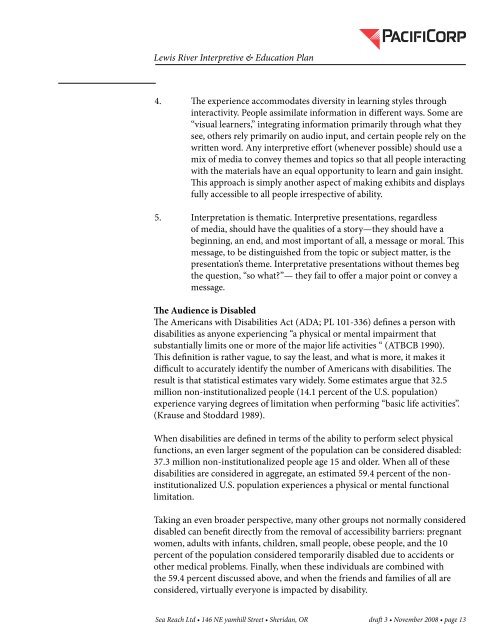The Lewis River Hydroelectric Projects - PacifiCorp
The Lewis River Hydroelectric Projects - PacifiCorp
The Lewis River Hydroelectric Projects - PacifiCorp
You also want an ePaper? Increase the reach of your titles
YUMPU automatically turns print PDFs into web optimized ePapers that Google loves.
<strong>Lewis</strong> <strong>River</strong> Interpretive & Education Plan<br />
4. <strong>The</strong> experience accommodates diversity in learning styles through<br />
interactivity. People assimilate information in different ways. Some are<br />
“visual learners,” integrating information primarily through what they<br />
see, others rely primarily on audio input, and certain people rely on the<br />
written word. Any interpretive effort (whenever possible) should use a<br />
mix of media to convey themes and topics so that all people interacting<br />
with the materials have an equal opportunity to learn and gain insight.<br />
This approach is simply another aspect of making exhibits and displays<br />
fully accessible to all people irrespective of ability.<br />
5. Interpretation is thematic. Interpretive presentations, regardless<br />
of media, should have the qualities of a story—they should have a<br />
beginning, an end, and most important of all, a message or moral. This<br />
message, to be distinguished from the topic or subject matter, is the<br />
presentation’s theme. Interpretative presentations without themes beg<br />
the question, “so what”— they fail to offer a major point or convey a<br />
message.<br />
<strong>The</strong> Audience is Disabled<br />
<strong>The</strong> Americans with Disabilities Act (ADA; PL 101-336) defines a person with<br />
disabilities as anyone experiencing “a physical or mental impairment that<br />
substantially limits one or more of the major life activities “ (ATBCB 1990).<br />
This definition is rather vague, to say the least, and what is more, it makes it<br />
difficult to accurately identify the number of Americans with disabilities. <strong>The</strong><br />
result is that statistical estimates vary widely. Some estimates argue that 32.5<br />
million non-institutionalized people (14.1 percent of the U.S. population)<br />
experience varying degrees of limitation when performing “basic life activities”.<br />
(Krause and Stoddard 1989).<br />
When disabilities are defined in terms of the ability to perform select physical<br />
functions, an even larger segment of the population can be considered disabled:<br />
37.3 million non-institutionalized people age 15 and older. When all of these<br />
disabilities are considered in aggregate, an estimated 59.4 percent of the noninstitutionalized<br />
U.S. population experiences a physical or mental functional<br />
limitation.<br />
Taking an even broader perspective, many other groups not normally considered<br />
disabled can benefit directly from the removal of accessibility barriers: pregnant<br />
women, adults with infants, children, small people, obese people, and the 10<br />
percent of the population considered temporarily disabled due to accidents or<br />
other medical problems. Finally, when these individuals are combined with<br />
the 59.4 percent discussed above, and when the friends and families of all are<br />
considered, virtually everyone is impacted by disability.<br />
Sea Reach Ltd • 146 NE yamhill Street • Sheridan, OR draft 3 • November 2008 • page 13
















